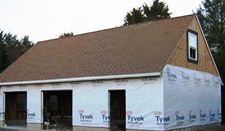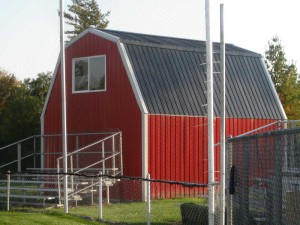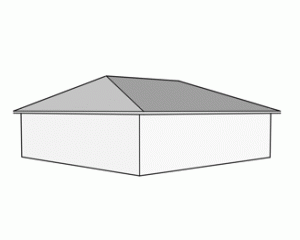Reader JEREMY writes:
“Good Morning and Happy New Year!
We are currently in the process of building a house inside a pole barn, and have noticed condensation on the inside walls and roof when we heat it. We do not have any vents installed yet, and would like to know if the condensation will stop after we get the walls/insulation/sheetrock put up and vents added to the attic. We are very concerned about this issue, so any advice you can give will be greatly appreciated by our family J!
Here are a few details about our current building:
-No vents to the outside yet, but plan to install venting in the attic soon.
-Regular R-panel metal roof and walls installed on wood runners hanging on treated wood posts.
-Concrete slab floor that has been poured for about 2 years
-Bubble wrap insulation between metal outside and wood runners-not sure of r-value or details and it seems to be sealed well
-When heating we are using an old propane central heating unit, but did not have exhaust on the heater ran to the outside so thinking that could contribute to the condensation
-also use a wood stove to supplement heat when we are out in the building working
Let me know what you think when you have time, and thank you!”
Jeremy ~
Mike the Pole Barn Guru
My first guess is there is not a well sealed vapor barrier under your concrete slab. if not, things which will help – make sure ground around your building is sloped away at at least a 5% slope for 10 feet or more. If you do not have gutters, get them. Have downspouts discharge at least 10 feet away from the building. If excess water is still present, it may be necessary to install drain tiles around the perimeter of your building.
If you have not insulated the perimeter of the slab, do so. Follow the guide for Frost-Protected Shallow Foundations (https://www.hansenpolebuildings.com/2016/11/frost-protected-shallow-foundations/).
Seal the surface of the concrete slab.
 Take off the steel siding, remove the reflective radiant barrier from the walls and install a quality building wrap (like Tyvek), then put the siding back on. The barrier is keeping moisture in your building, whereas a building wrap allows moisture to exit. Completely fill the wall cavities with insulation. Place a well sealed vapor barrier between framing and gypsum wallboard to be installed on the walls. Do not place a vapor barrier between the ceiling drywall and the roof framing above.
Take off the steel siding, remove the reflective radiant barrier from the walls and install a quality building wrap (like Tyvek), then put the siding back on. The barrier is keeping moisture in your building, whereas a building wrap allows moisture to exit. Completely fill the wall cavities with insulation. Place a well sealed vapor barrier between framing and gypsum wallboard to be installed on the walls. Do not place a vapor barrier between the ceiling drywall and the roof framing above.
Install fully vented soffit panels along the eave sides and a continuous ridge vent.









And you didn’t jump all over this???
“-We do not have any vents installed yet,
-No vents to the outside yet,
-When heating we are using an old propane central heating unit, but did not have exhaust on the heater ran to the outside”
Every once in a while I leave something open just to find out if readers are paying attention.
Propane heater venting is the process of removing products of combustion out of a structure to the outside atmosphere.
Propane heaters are required to utilize approved vent materials as well as installation procedures according to NFPA 54. Improper vent installation or the absence of venting when required can lead to extremely hazardous conditions within a home or building.
Propane heaters are subject to venting rules as written in NFPA 54. Although propane is a clean burning gas, heaters meeting or exceeding specified BTU ratings are subject to exhaust ventilation requirements for health and safety reasons. Not only is the venting of propane heaters a protective concern and requirement but the removal process of flue gases itself is also a subject requiring care and planning. The absence of ventilation, improper materials and/or incorrect installation of the venting can result in Carbon Monoxide poisoning. Damage to venting can occur if the combustion of LP Gas is incomplete as well. Do not attempt to install, modify or repair ventilation equipment without consulting the heater manufacturer, licensed HVAC professional or your propane company.
furthermore, propane heat produces a ton of moisture in the air – this is far more likely to be the problem than the old concrete slab IMO – I believe that every pound of propane burned produces one pound of water vapor. So this combined with the lack of ventilation is a recipe for all kinds of condensation …
Burning a gallon of propane will produce roughly a gallon of water vapor.
That is an incorrect statement about propane heaters generating a ton of moisture. All gas fired heaters remove moisture through evaporation. The heated air in a home will be dryer with a gas fired furnace than with an electric heat strip. I AM A LICENSED HVAC CONTRACTOR IN TEXAS WITH 20 years experience
Propane is a gas produced during petroleum production. Propane is a three-carbon alkane (a molecule composed of three carbons and five hydrogen atoms).
Propane reactions occur due to the give and take of atoms. Protons and electrons carry a charge which is either positive (protons) or negative (electrons), which determines the properties of their associated atoms. Chemical reactions occur whenever there’s some form of chemical imbalance; the reaction changes the properties of the associated compound. This is how water and carbon dioxide can be formed during combustion.
Water becomes a by-product of propane through the process of combustion. Combustion occurs when there’s between 1.8 percent to 8.6 percent propane and 91.4 percent to 98.2 percent air. Any more or less propane, and combustion can’t occur completely. This results in an improper equation and creates deadly carbon monoxide gas. The equation for the complete combustion of propane is as follows: 3CH8 + 5O2 > 3CO2 + 4H2O.
Propane’s three-carbon alkane (3CH8) is added to five molecules of oxygen (O5). When heat is applied to the mixture, combustion occurs, and the atoms begin to interact violently. The electrons and protons push and pull on each other until balance is restored, creating carbon dioxide (3CO2) and water (4H2O). This process is continued until the propane, oxygen or heat is exhausted. The combustion of propane then results in the creation of relatively large amounts of water.
This article might be of interest in the gas fired heat/humidity discussion: https://www.energyvanguard.com/blog/73469/Does-a-Gas-Furnace-Dry-Out-the-Air-in-Your-Home
Yes indeed. 🙂